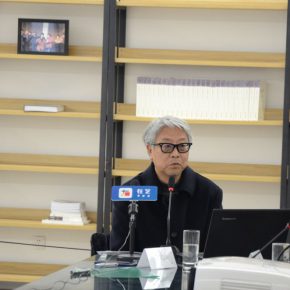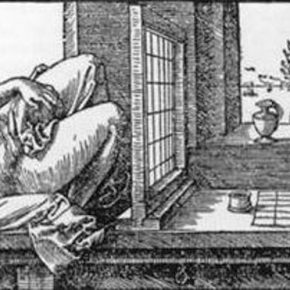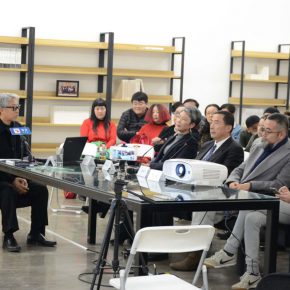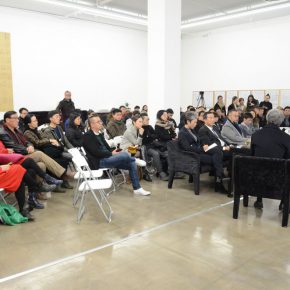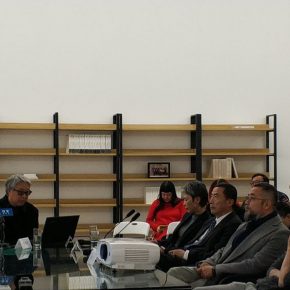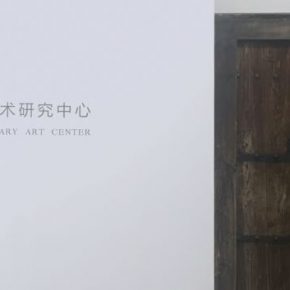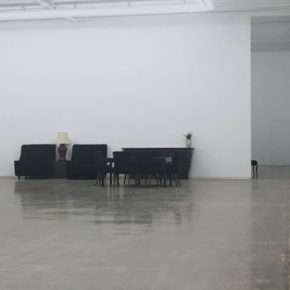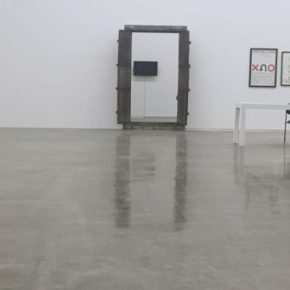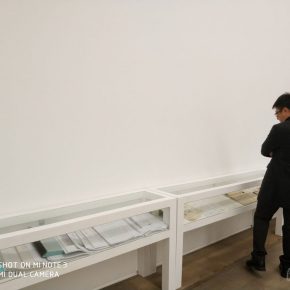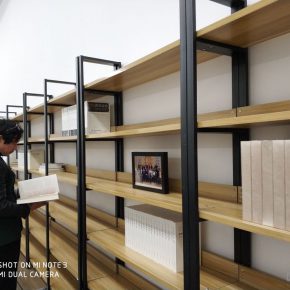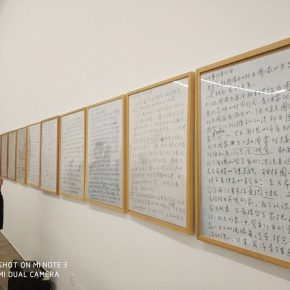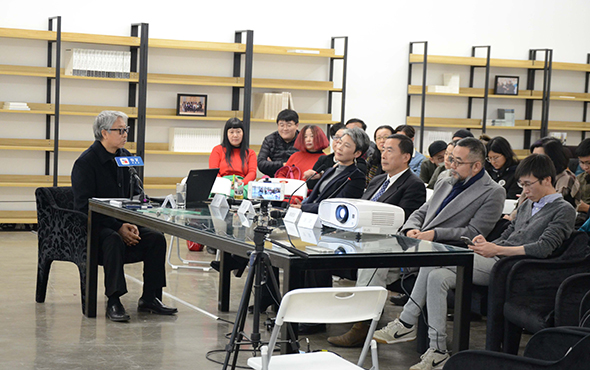
On November 16, 2017, Gao Minglu’s solo exhibition entitled “Window, Grid and Frame”, sponsored by the Yuan Art Museum and Yuan Foundation, debuted at the Yuan Art Museum. Gao Minglu graduated from Harvard University, with a doctoral degree, and he is a professor of art history and architectural history at the University of Pittsburgh in the United States. Since the 1980s, Gao Minglu has been devoting himself to the study of contemporary art criticism and cultural history. In order to promote the development of contemporary art, he founded the “Gao Minglu Contemporary Art Center”, a non-profit academic institute, engaged in academic research, documental collation, art exhibitions, academic conferences, and editorial & publishing work. But Gao Minglu Contemporary Art Center was temporarily evacuated due to various reasons.
Strictly speaking, “Window, Grid and Frame →?” is not an art exhibition, but an exhibition of art theory, and the exhibition restores & reproduces Gao Minglu Contemporary Art Center. When you cross the ancient wooden doorway of the exhibition hall, it symbolizes that you have entered the site of Gao Minglu Contemporary Art Center: it displays Gao Minglu’s manuscripts on research & writing, as well as the published literature, and the poster of the “1989 China/Avant-Garde Exhibition” that Gao planned, as well as the furnishings, such as bookshelves, tables and chairs of Gao Minglu Contemporary Art Center.
At 15:00, Gao Minglu delivered a lecture entitled the “Window, Grid and Frame →?” for the audience. “The Teaching of Measurement” is a print created by Dürer in 1525, with a theme that is related to the painting itself, and there is a grid between the artist (or a draftsman) and the nude, in addition to a grid on the artist’s desktop. In the lecture, Gao Minglu regarded this painting as a guide, interspersed with the classical paintings of Western art history, and the representative speeches by philosophers & art historians, explained what the “window”, “grid” and “frame” were, to the audiences who were present at the lecture, and how these three things construct contemporary Western art history.
The “window”, “grid” and “frame” are three different narrative patterns of art history based on the theory of representationalism in Western art history, which are used to summarize the different historical phases and essential characteristics of the development of the theory of Western art history, so that, the audience can clearly understand the inherent logic of the phased evolution of the narrative of Western art history & the creative concept. On the basis of Gao Minglu’s theory, the development of Western history can be divided into three phases.
“Window”: Through the Window to Watch the TruthThe first phase (from the early 18th century to the beginning of the 20th century) was in the mode of “window”, with a focus on the artistic spirit & artistic style of the times. It is a window for a cube, through the window, the viewer’s visual ability can show a real three-dimensional image, while the presentation of such a real three-dimensional image requires a systematic and self-contained a priori form. For example, the perspective method is a priori form of image.
Gao Minglu believed that in the phase of “window”, the classic realism art was the classic representative of art, and the art needed to be expressed by the symbolic language (where the symbol was a way instead of symbolism). Western art theory highlighted the discussion on how to make external objects appear in our perception system through a priori illustration, for example, Alois Riegl’s theory of “From Tactile Sense to Visual Sense”, Heinrich Wolfflin’s theory of “Spirit of the Times” and “Spirit of Nationality”. Gao Minglu said that, it was obvious that from Hegel’s “a priori” to Riegl and Wolfflin, as well as Erwin Panofsky, “window” phase focused on the humanistic spirit of the times and the nation, etc., as well as the development of an artistic style.
“Grid”: The Depth behind the PlaneThe second phase (from the early 20th century to the 1950s) was the symbolic reproduction, namely the mode of “grid”, with the focus on the art itself. “Grid” was flat, a symbol for a cube. Gao Minglu said: “Grid is flat, but it does not mean that it does not have depth. It pursues the depth hidden behind the plane of the cube, that is, the philosophy, idea and thought of art, but it needs to use the means of symbol, which can be abstract, and also realistic, figurative images) to achieve it.”
In the mode of “grid”, the artists were concerned about “how to see” instead of “what to see”, and the images tended to be more and more symbolized, planed, and abstract. The form and performance of art became the focus, and the abstractionism, minimalism, and post-minimalism belonged to this historical phase. The theory of art focused on the relationship between the images and the stories behind the images. Linguistics, Saussure’s structural semiotics and Panofsky’s iconology had greatly influenced the research method of art history in this phase, and the most classic representation was the study on Jan Van Eyck’s “The Arnolfini Portrait” by Panofsky.
“Frame”: Art in the ContextThe third one (after the 1960s) was the phase of “the reproduction of terms”, namely the mode of “frame”. The frame was the structure and composition conditions for a cube, which did not only need to think of and reflect on the symbol itself, and also needed to think of the context of the occurrence of the symbol. It was related to the emergence of an important tendency in philosophy and art since the 1960s. The construction of meaning was controlled by the discourse. When we say a sentence, we are both dominated by the grammar and discourse conditions.
By the same token, it is necessary for art to think of both the art itself (form, media, etc.), and the context (idea, concept, connotation, etc.) of the art. Gao Minglu believed that, it was like the borders and conditions of a frame as a cube, the process of the finishing of the artistic meanings was also interfered with and dominated by the context as the boundary & conditions. Conceptual art was the art representation in this phase, while the post-structuralism was the representation of the theories of art research.
Besides the interpretation of the “window”, “grid” and “frame”, as well as his narrative patterns, Gao Minglu also briefly introduced the theory of “Yi Pai, or Yi School” in his lecture. After the lecture, the honored guests including Sheng Wei, the deputy editor of “Art” magazine of the China Artists Association, a critic and curator, the sculptor Sui Jianguo and performance artist Xiao Lu, as well as the audiences present at the lecture, had an interaction with Gao Minglu.
Western art theory has a great influence on and support of contemporary art, especially the development of Chinese contemporary art, how to thoroughly and correctly understand Western art theory is a compulsory course in Chinese contemporary art. The exhibition & lecture of “Window, Grid and Frame →?” offers people an epistemology & thinking of how to think of different cultures. Only with the speculative thinking and methods can we better understand contemporary art and create better contemporary art.
Photo and text by Zhong Yuwei, translated by Chen Peihua and edited by Sue/CAFA ART INFO
(Part of the photos courtesy of the organizer)


